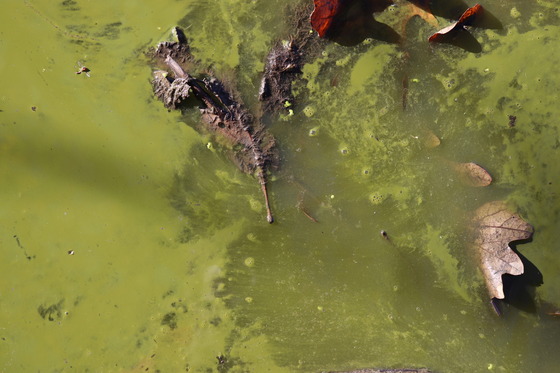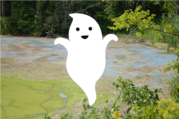 Fall Blooms and Waterfowl Hunting Season
Can blue-green algae still form blooms in the fall?
Yes! While October in Wisconsin marks the wonderful season of foliage, football games, pumpkin-flavored everything, apple picking, haunted hayrides, and hunting, it can also mean blue-green algae. Blue-green algae are infamous for making a fall exit by forming blooms during warmer days and lake turnover events. Lake turnover is a natural phenomenon that occurs in the spring and autumn when the cooler top and warmer bottom layers of a lake mix. Deeper water containing less oxygen and more nutrients rises to the surface. While this temporary environment may be stressful to many aquatic organisms, blue-green algae near the surface can thrive because of their preference for warm water and ability to photosynthesize, produce oxygen, and fix their own nitrogen. With this advantage, blue-green algae can still form blooms in the fall.
 An example of a fall bloom in one of Dane County's waterbodies. This photo was taken October of 2021. Image courtesy of the Wisconsin Department of Natural Resources.

How does blue-green algae affect hunting season?
According to the Wisconsin Department of Natural Resources, there are an estimated 60,000 waterfowl hunters in Wisconsin as of 2022. This puts Wisconsin at fourth in the nation. Many of these hunters rely on the help of their canine companion.
While not widespread, toxicity from blue-green algae is still a concern for waterfowl hunting dogs. Hunting dogs might retrieve an animal from a location in a river, lake, or pond where higher concentrations of blue-green algae and their toxins are present. As dogs are retrieving from surface water, they may ingest impacted water incidentally as they carry a carcass while swimming, or intentionally as their thirst grows from rigorous activity. Waterfowl hunters may want to take some water safety precautions for their furry friend this fall to keep them safe and healthy.
How can hunters protect their dogs?
Hunters should:
- Be on the lookout for potentially unsafe water conditions and avoid water that looks like green “pea soup," appears to have spilled latex paint on the surface, is discolored, or has surface scum, foam, or algal mats.
- Bring along a supply of clean, fresh water for their dogs to drink.
- Prevent their dogs from submersing themselves in water that is clearly discolored or has surface scum, foam, or algal mats.
- Stop their dogs from licking algae or scum off their fur after they swim.
- Wash their dogs off thoroughly with fresh, clean water if they swim in discolored or scummy water.
After a potential exposure, hunters should watch their dog for signs of lethargy, loss of appetite, vomiting, diarrhea, or seizures. If their animal shows any of these symptoms, they should contact their veterinarian immediately.
Local health and tribal agencies can share this fact sheet with hunters to promote education about blue-green algae and dog safety.
|
We Want to Hear from You!
It’s no question that harmful algal blooms are a hot topic among all audiences. During the last year, our program has received tons of great HAB-related questions from waterfront property owners, researchers, local health and environmental agencies, and members of lake association groups. Some of the most popular questions were related to topics including:
- Socioeconomic impacts of HABs.
- Climate change and HABs.
- Neurologic effects of HABs.
- Chronic health implications of HABs.
- HAB treatment and mitigation.
Do you have a burning HAB-related question or research interest that you want to learn more about? Let us know! We would love to feature and address your suggestion or question in an upcoming e-newsletter. You can send your ideas to us by emailing the HAB program at dhshabs@dhs.wisconsin.gov.

Let's Get Social!
This issue's sample posts:
Example 1:
Waterfowl hunting season has begun! Did you know that as of 2022, Wisconsin has about 60,000 waterfowl hunters—the fourth highest number in the U.S.? Many of these hunters use dogs to retrieve their harvested ducks, grouse, pheasants, and geese. With blue-green algae still capable of forming blooms in the fall, hunters can keep their dog’s safety in mind by becoming familiar with potentially harmful water conditions. View this fact sheet to learn more: https://www.dhs.wisconsin.gov/publications/p0/p00089.pdf. Suggested accompanying photo: https://commons.wikimedia.org/wiki/File:Waterfowl_hunting.jpg
|
Example 2:
For anyone feeling “spooky” this October, we recommend posting this Joke of the Day:
 |
|
|
Q: What type of “algae” is made of bacteria, can produce toxins, and grows in a haunted lake?
A: BOO-green algae! Learn more at the DHS website.
|
|
Stay in Touch

Missed a past issue? Previous issues are available on our Resources for Health Professionals webpage.
Email us your burning questions! If others can benefit from hearing the answer to your question, we’ll feature it in a future issue.
Remember that we are always available for consultation on any HAB health-related issue by email or phone (608-266-1120).
|
|